Samsung's Galaxy S 4: Introduction & Hands On
by Anand Lal Shimpi on March 14, 2013 7:30 PM EST- Posted in
- Smartphones
- Samsung
- Mobile
- Galaxy S 4

Since 2010 Samsung has grown to become not only the clear leader in the Android smartphone space, but the largest smartphone manufacturer in the world. Its annual iteration of the Galaxy S platform is now arguably one of the most widely anticipated smartphone launches each year.
Like clockwork, tonight Samsung announced the Galaxy S 4: a 5-inch 1080p smartphone, and the new flagship for the Galaxy brand. We just finished learning about the device and spent a short time playing around with it.
Most of the hardware specs are known quantities. The 5-inch Super AMOLED display features a 1080p resolution, for a pixel density of over 441 ppi. The chassis is plastic with a metallic looking rim around the edge. Like most Samsung devices, the Galaxy S 4 feels well built although the plastic construction makes it the polar opposite of HTC's One - and truthfully in a different league altogether. I don't personally believe Samsung's use of plastics is terrible, but it definitely doesn't lend itself to the same sort of remarkable designs we see from HTC or Apple. On the plus side the SGS4 feels very light (it's even lighter than the SGS3). The tradeoff between material feel and weight is one that has a spectrum of solutions. Samsung remains on prioritizing weight and cost, which is understandable given the success the company has seen thus far.
The SGS4 feels surprisingly comfortable in hand, partly due to weight and party due to the device's proportions. I didn't mind the size at all.
The Galaxy S 4 is available in two colors: white frost and black mist. I played with an international SGS4 variant in white frost.
| Smartphone Spec Comparison | ||||||
| Apple iPhone 5 | HTC One | Samsung Galaxy S 3 | Samsung Galaxy S 4 | |||
| SoC | Apple A6 1.3GHz | Snapdragon 600 1.7GHz | Snapdragon S4 1.5GHz | Exynos 5 Octa (1.6/1.2GHz) or Snapdragon 600 1.9GHz | ||
| DRAM/NAND/Expansion | 1GB LPDDR2, 16/32/64GB NAND | 2GB LPDDR2, 32/64GB NAND | 2GB LPDDR2, 16/32GB NAND, microSD | 2GB LPDDR3, 16/32/64GB NAND, microSD | ||
| Display | 4.0-inch 1136 x 640 LCD | 4.7-inch SLCD3 1080p, 468 ppi | 4.8-inch Super AMOLED 720p, 306 ppi | 5-inch Super AMOLED 1080p, 441 ppi | ||
| Network | 2G / 3G / 4G LTE Cat 3 | 2G / 3G / 4G LTE Cat 3 | 2G / 3G / 4G LTE Cat 3 | 2G / 3G / 4G LTE Cat 3 (depending on region) | ||
| Dimensions | 123.8mm x 58.6mm x 7.6mm | 137.4mm x 68.2mm x 4mm - 9.3mm | 136.6mm x 70.6mm 8.6mm | 136.6mm x 69.8mm x 7.9mm | ||
| Weight | 112g | 143g | 133g | 130g | ||
| Rear Camera | 8MP | 4MP w/ 2µm pixels | 8MP | 13MP | ||
| Front Camera | 1.2MP | 2.1MP | 1.9MP | 2MP | ||
| Battery | Internal 5.45 Wh | Internal 8.74 Wh | Removable 7.98 Wh | Removable 9.88 Wh | ||
| OS | iOS 6.1.2 | Android 4.1.2 | Android 4.1.2 | Android 4.2.2 | ||
| Connectivity | 802.11a/b/g/n, BT 4.0, USB 2.0, GPS/GNSS | 802.11ac/a/b/g/n + BT 4.0, USB2.0, GPS/GNSS, MHL, DLNA, NFC | 802.11a/b/g/n, BT 4.0, USB 2.0, NFC, GPS/GNSS, MHL | 802.11a/b/g/n/ac (HT80) + BT 4.0, USB 2.0 NFC, GPS/GNSS, IR LED, MHL 2.0 | ||
The back cover remains removable, as does the 9.88Wh battery:
Internally, there’s 2GB of memory and 16 - 64GB of on-board NAND, with a microSD card slot for optional storage expansion.
As expected, the SoC will vary depending on region. Samsung will offer either its own Exynos 5 Octa or a 1.9GHz quad-core Snapdragon SoC from Qualcomm. Given the clock speed and the timing, I would assume Samsung is talking about a Snapdragon 600 but the only official word from Samsung is the 1.9GHz quad-core Snapdragon. Update: Qualcomm has confirmed that this is a Snapdragon 600.
The Exynos 5 Octa side is a bit more interesting. Samsung is calling the SoC a 1.6GHz Octa-core part, but that appears to be the clock speed for the four Cortex A7 cores. The four Cortex A15 cores will run at up to 1.2GHz, which should help keep power consumption manageable. We’ve been wondering for a while what clock speeds we’d see the Cortex A15s run at in smartphones, and I believe this is the first line drawn in the sand. If we go back to Samsung’s ISSCC disclosure of Exynos 5 Octa power consumption, it looks like peak CPU power consumption should be somewhere around 2W - definitely better than what we saw from Exynos 5 Dual in the Nexus 10. Again, no surprises here given that we’re talking about a smartphone - it’s just interesting to see. Update: There seems to be some confusion as to whether or not the A7/A15 clocks are 1.6/1.2 or 1.2/1.6. I was told the former and that's what I wrote down, but it's entirely possible that the information given wasn't correct. I'm awaiting for further confirmation. Although 1.2GHz makes sense for a max clock for the A15s, 1.6GHz is a bit high for A7s if they're truly to be used to keep power consumption down. I can see it working either way.
Samsung isn’t ready to talk specifics about what SoCs will end up in what regions. We weren’t allowed to run any downloaded applications or benchmarks on the hardware at the event, nor were we told what SoCs were used in the demo hardware. Both SoCs should be good choices though.
Similarly, there’s no disclosure on what baseband silicon is being used although LTE support will be offered depending on the region. It’s highly likely that we’re looking at another MDM9x15 with a discrete applications processor (Snapdragon or Exynos 5 Octa). All of the expected wireless connectivity options are present including 802.11ac and BT 4.0. Samsung is claiming support global LTE roaming (up to six different bands) and FDD/TDD LTE.
As is the norm these days the Galaxy S 4 comes with both a front and rear facing camera. The front facing camera features a 2MP sensor and is capable of recording video at 1080p30. The rear facing camera sees a move to a 13MP sensor with flash. No word on the max aperture or focal length of the camera systems at this point.
The Galaxy S 4 will ship with Android 4.2.2. It will be available both internationally and in the US starting sometime in Q2 (Update: first shipments will be in April). US operators signed up to carry the Galaxy S 4 are AT&T, T-Mobile, Sprint, Verizon, Cricket and US Cellular.


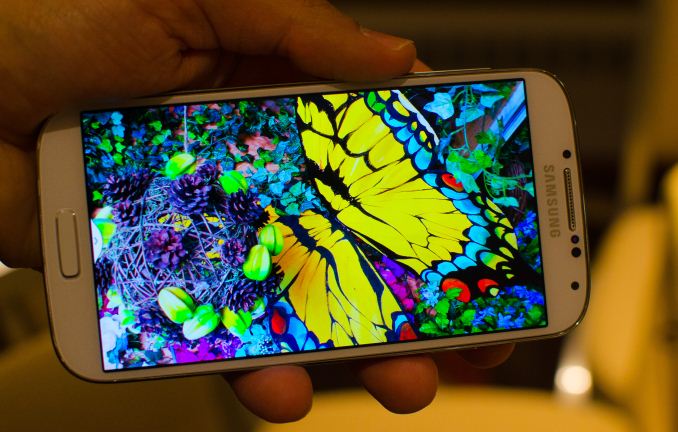
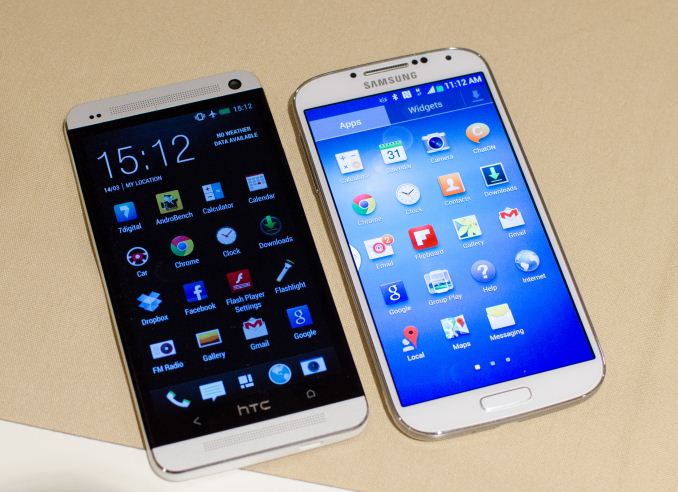

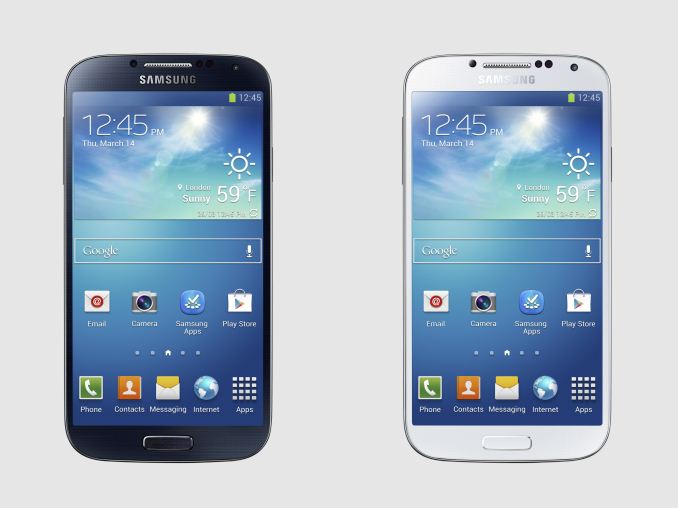
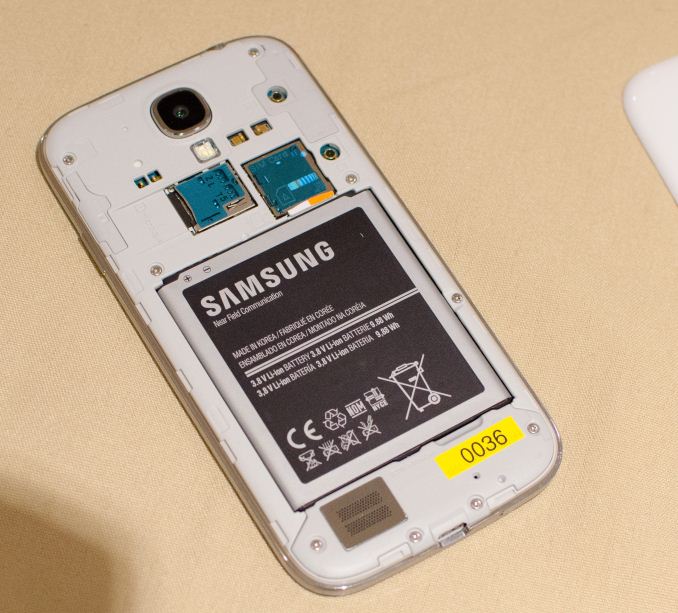
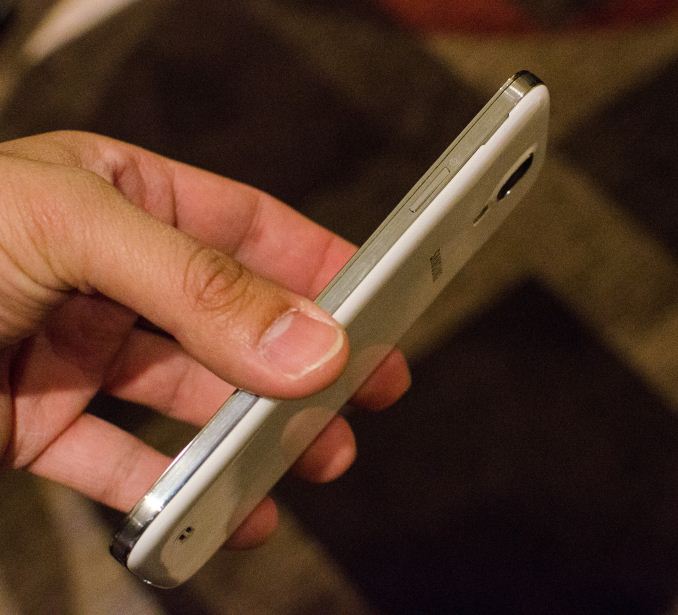















206 Comments
View All Comments
toldenburger - Saturday, March 16, 2013 - link
Yeah I was wondering about this too. Couples of times obvious lag between pressing a button and something happening. Also some scrolling lag. And definitely when using these new s-features which I think are a gimmick. Also from someone who has not used Android for a long time, is the UI supposed to look so non-conform? Looks different in a lot of places and in my mind ugly especially in the 'messaging' app.beginner99 - Friday, March 15, 2013 - link
Well nothing surprising. In the end all those top of the line phones seem a tad too big. I would probably choose the S4 over HTC One. Bigger screen in almost same sized body and lighter, More importantly SA had SD-card slot. Sou you can cheap out with the 16 GB and get a large SD card.BPB - Friday, March 15, 2013 - link
The One's camera has me seriously considering it. I have a Lumia 920 through work but am looking to leave the job and as a result the phone. Sprint doesn't have the 920, so I think the camera of the One will get me over the S4. I really like being able to take good pictures in low light with my 920, so getting the One makes sense for me. Having only 32GB with the 920 hasn't been a problem for me, so that or more with the One will be fine.krumme - Friday, March 15, 2013 - link
Go check the pictures before you do. The ones i have seen have been very disapointing bordering on there must be a flaw with the phone. The corners are unbelieveble unsharp, and are really big. Second, i dont quite see the benefit of going to 4pix. So sad, it could have change the idiotic race for more mpix, but something went wrong with the execution.BPB - Friday, March 15, 2013 - link
Check out Engadget's review. They beg to differ:http://www.engadget.com/2013/03/12/htc-one-review/
Galcobar - Friday, March 15, 2013 - link
Normally not one to complain but since Blackberry 10's launch on Jan. 30 Anandtech has published six phone hands-on articles, yet still hasn't come out with anything on the Z10 since you closed the Live Blog with "11:23AM EST - The announcement is coming to a close, thank you all for following, we'll have more on the announced devices later today."Considering RIM (technically the name still hasn't changed) was handing out Z10 at the launch, I'd much like to know why we've not seen anything on a platform which, while ridiculously behind the top two, still holds more than double the share of the fourth-place Windows Phone (who has gotten Anandtech phone reviews). http://gigaom.com/2013/03/06/comscore-android-stil...
Mugur - Friday, March 15, 2013 - link
I hate to see (again) that Samsung is selling the same phone with different internals. Fortunately for me, I think they will screw (again) only the US market... :-)Krysto - Friday, March 15, 2013 - link
It seems like the A15 cores were underlocked from the rumored 1.8 Ghz to be more in line with the S4 Pro's performance in US, even though it's clocked at 1.9 Ghz.mattgmann - Friday, March 15, 2013 - link
This phone seemingly has it all. Too bad the off-contract price is surely $650+. I'll wait for whatever google has next.Gunbuster - Friday, March 15, 2013 - link
I honestly do not understand the current Samsung design language. I always have the lingering thought in the back of my head that it looks like some kind of prototype medical device for socialites to do a home sonogram with. They consistently look plasticky, fragile, and every unit not wiped down for the press shot is a hot greasy mess.